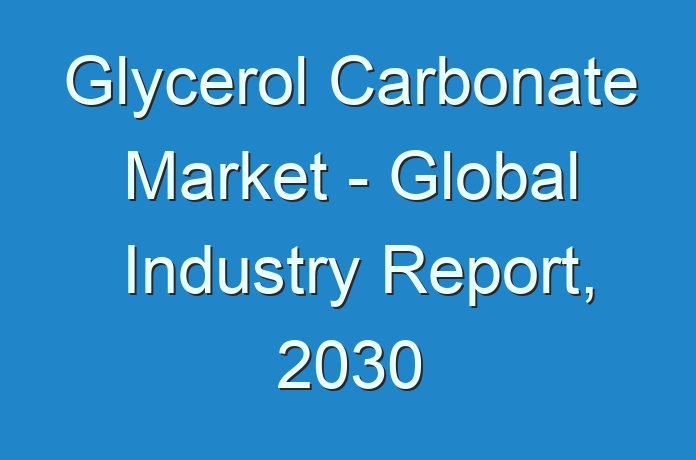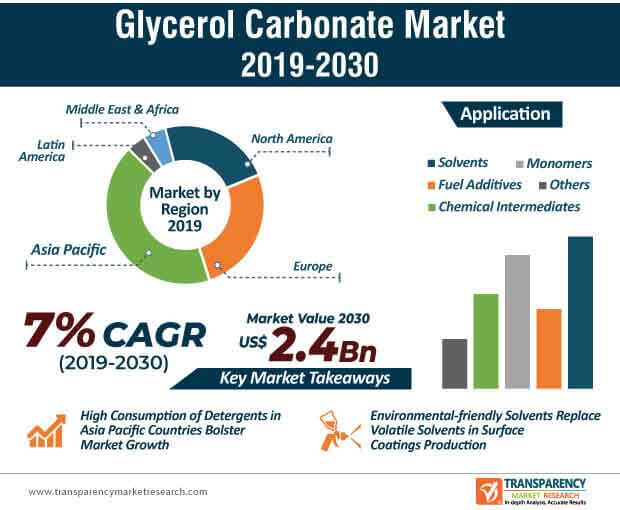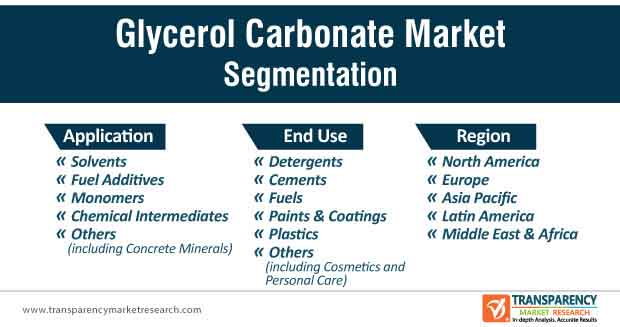
Glycerol Carbonate and EP Crucial for Mass Production of Detergents and Paints
Glycerol is a waste product of biodiesel, where the latter is made from natural vegetable oils and fats. Rapid growth of the biodiesel industry has created increasing volumes of glycerol waste. Hence, companies in the glycerol carbonate market are capitalizing on this issue to process waste glycerol, which involves the reaction of carbon dioxide with methanol and other procedures, ultimately creating an important chemical intermediate called glycerol carbonate. As such, glycerol carbonate is being converted into epoxy propanol (EP), which is used in the large-scale production of detergents, healthcare products, and industrial paints & coatings.
Epoxy propanol is being primarily manufactured in Japan and the U.S. This is evident, since the per capita consumption of detergents is surging in countries of Asia Pacific including India, China, and other parts of the world such as Brazil. Thus, manufacturers in the glycerol carbonate market are focusing on capacity additions to meet end user demands.

To gauge the scope of customization in our reports Ask for a Sample
Minimal Purification of Glycerol Facilitates Cost-efficient EP Production
The conversion of glycerol to produce epoxy propanol is gaining popularity as a sustainable solution for mass production of detergents and healthcare products. Epoxy propanol is conventionally produced via epoxidation of ally alcohol with hydrogen peroxide or the other method of epichlorohydrin with a caustic agent. However, both these methods generate toxic byproducts such as hydrochloric acid, thus resulting in costly purification processes for EP production to prevent acid residues from entering the environment. Hence, the conversion of glycerol into glycerol carbonate is being highly publicized as a cost-efficient method for the EP production in the glycerol carbonate market.

Get an idea about the offerings of our report from Report Brochure
Glycerol does not require any significant purification prior to combination with dimethyl carbonate (DMC). This has improved economics for the production of EP, thus minimizing waste streams in the glycerol carbonate market.
Thermochemical Processes Minimize Purification Costs for Glycerol Used in Biodiesel Production
The main asset for economic development of any country is energy. However, in the past two decades, the world has been facing energy and environmental crisis due to the depletion of crude oil reserves and the ever-increasing fuel demand. This has catalyzed bioenergy development, which serves as an environment-friendly alternative to crude oil. As such, companies in the glycerol carbonate market are developing biofuel concerning the disposal or revalorization of byproducts such as glycerol.
Biodiesel is an effective alternative to overcome global petroleum depletion. However, unique challenges in the biodiesel industry such as quality & acceptance issues and issues in waste management are concerning companies in the glycerol carbonate market. Hence, companies should adopt thermochemical processes for the purification of glycerol, which can be further used for the production of biodiesel.
Energy Generation Industry Revives Market Growth as Coronavirus Pandemic Subsides
Worldwide lockdown norms due to the COVID-19 (coronavirus) outbreak in several countries has affected the sales of biofuel. This has directly impacted the revenue generation activities in the glycerol carbonate market, since crude glycerol is processed to produce biofuel. More than 30% of the energy consumed in the U.S. is via transportation. Due to lockdown regulations and stringent transportation norms by the local and federal agencies, the demand for biodiesel has suffered in the past couple of months. With relaxation in lockdown rules, companies in the glycerol carbonate market can hope to revive market growth.
e-Commerce deliveries have been generating stable revenue streams for glycerol carbonate manufacturers, owing to the large transportation network in the U.S. which demands biofuel. However, plant shutdowns have severely affected the business for glycerol carbonate manufacturers. As the COVID-19 pandemic is beginning to subside in several countries, manufacturers can hope for developments in market growth.
Safe and Environment-friendly Solvents Highly Preferred by Surface Coating Manufacturers
Companies in the glycerol carbonate market are increasing their R&D efforts to manufacture safe and environment-friendly solvents. Such developmental production practices have helped to replace hazardous and highly volatile solvents such as methylene chloride, acetone, and aromatic solvents. As such, the glycerol carbonate market is projected to expand at a favorable CAGR of 7% during the forecast period. Hence, manufacturers are increasing their production capabilities to develop effective glycerol carbonates that serve as excellent solvents for organic and inorganic systems.
Glycerol carbonate manufacturers are casting a laser-like focus in surface coatings and plastic products. On the other hand, intermediates for polyester preparation are in high demand. The trend of VOC (Volatile Organic Compound)-free solvents is gaining prominence in the market landscape. Manufacturers are establishing stable revenue streams in the fuel sector to capitalize on value-grab opportunities.
Glycerol Carbonate Market in the Asia Pacific to Grow with Introduction of Highly Functional Plastic Products
The U.S. and governments of countries in Europe have broadcast obligatory rules for the use of biodiesel in the transportation sector. This has bolstered the demand for biodiesel in the glycerol carbonate market in the U.S. and Europe. As such, the market is estimated to reach a value of US$ 2.4 Bn by 2030. Biofuel has been gaining increased popularity as an alternative to fossil fuel resources. Hence, manufacturers are acquiring proficiency in enhanced conversion methods to transform glycerol into valuable products. Selective oxidation, etherification, polymerization, and reduction are common conversion methods used by glycerol carbonate manufacturers.
Biodegradability of biofuel is empowering the transportation sector in the U.S. and Europe. However, Asia Pacific is also predicted for exponential growth during the assessment period. Since plastic is highly functional and aesthetic material in the modern world, manufacturers are boosting their production levels in polymers and plastics to bolster market growth.
Looking for Regional Analysis or Competitive Landscape in Glycerol Carbonate Market, ask for a customized report
Analysts’ Viewpoint
Energy generation is one of the main sources of economic development of a country. Due to the COVID-19 pandemic, the energy generation industry has suffered due to plant closures and is hoping for a revival in the second half of 2020. As such, manufacturers in the glycerol carbonate market are gaining strong business grounds in the transportation sector of the U.S. and Europe due to mandatory norms for the use of biofuel. However, the production of biofuel leads to increased waste of glycerol. Hence, manufacturers should process glycerol to produce epoxy propanol, which is used in the large-scale production of industrial paints & coatings, detergents, and healthcare products.
Glycerol Carbonate Market: Overview
- Glycerol carbonate is used in key applications in separation of gas membrane. It is a promising chemical compound, owing to its superior chemical properties. It possesses outstanding biodegradability, high boiling point, and low toxicity. Glycerol carbonate is used directly as an intermediate in various industrial applications. Furthermore, ester compound of glycerol offers low VOC solvent properties. Ester carbonate compounds are primarily employed as additives in lithium-ion batteries. Glycerol carbonate is used as a curing agent in the cement & concrete industry.
- Glycerol is developing as a promising compound for environmental protection due to its potential as low volatile organic compound solvent. Additionally, glycerol carbonate plays an important role in synthesis of polyurethanes and polycarbonates. Glycerol carbonate is also emerging as a potential intermediate in the production of plastic surfactants, resins, and polymers. It acts as a new solvent in manufacturing of different types of materials. It also acts as a non-volatile solvent in the paint industry. Furthermore, glycerol carbonate acts as a component in the coatings industry. Glycerol carbonate is widely used as solvent in cosmetic, medical, and pharmaceutical industries.
- In terms of value, the global glycerol carbonate market is anticipated to expand at a CAGR of 7% during the forecast period to reach US$ 2.4 Bn by 2030
- Asia Pacific was the prominent region of the global glycerol carbonate market in 2019. The market in the region is expected to expand at a CAGR of more than 7.5% between 2020 and 2030.
- Plastic is one of the highly functional, esthetic, and sustainable material in the modern world. It has replaced several materials such as metal, concrete, and wood as it is lightweight, corrosion proof, economical, and esthetically appealing. Glycerol carbonate is a bio-based material, which is used in various applications such as polymers and plastics, polyesters, polycarbonates, polyamides, and polyurethane plastic coatings. Increase in adoption of bio-based material such as glycerol carbonate in the manufacture of plastics-based products is a major factor anticipated to drive the global glycerol carbonate market during the forecast period.
More Trending Reports by Transparency Market Research – https://www.prnewswire.com/news-releases/increased-demand-avenues-from-automotive-sector-fuel-expansion-of-noble-ferroalloys-market-tmr-301217975.html
Solvents to Drive Demand for Glycerol Carbonate
- Based on application, solvents was the major segment with 25% share of the global glycerol carbonate market in 2019. It is estimated to continue its dominance in the global glycerol carbonate market between 2020 and 2030. Glycerol carbonate is an eco-friendly compound that can be employed as a solvent in the production of various chemicals. It offers various advantages over the conventional organic solvents. As a solvent, glycerol carbonate is employed in numerous applications such as detergents, paints and coatings, personal care products, and lithium-ion batteries.
Rise in Demand for Glycerol Carbonate in Various End-use Industries
- In terms of end-use, plastics was the major segment with more than 30% share of the global glycerol carbonate market in 2019. It is estimated to continue its dominance between 2020 and 2030. Glycerol carbonate is employed directly or as an intermediate in various synthetic and industrial applications. Glycerol carbonate and its esters are potentially low-VOC solvents due to their high boiling point, low volatility, and high flash point. Thus, glycerol carbonate is used as electrolyte liquid carrier, general purpose solvent, additive in lithium-ion and lithium batteries, curing agent in concrete and cement, and additive in cosmetics. It is also employed in detergents, liquid gas separation system, and plant vitalizer. Furthermore, it is used as a blowing agent. Glycerol carbonate can also be converted into chemical intermediates, which are then employed in the production of surfactants, epichlorohydrin, and polymers.
Key Highlights of Glycerol Carbonate Market
- In terms of volume, Asia Pacific constituted prominent share of the global glycerol carbonate market in 2019. Demand for glycerol carbonate in the region is projected to rise during the forecast period, owing to rapid growth in the usage of plastics, cement, and detergents in Asia Pacific. The market in Asia Pacific is estimated to continue to expand at a rapid pace during the forecast period, owing to the increase in demand for glycerol carbonate in various end-use applications such as fuel, paints & coatings, and lithium-ion batteries in the region.
- Glycerol carbonate is often utilized in elastomers, surfactants, adhesives, inks, paints, electrolyzers, lubricants, and personal care products due to its excellent water solubility, biodegradability, low flammability, low toxicity, and low viscosity. Additionally, glycerol carbonate molecules that contain carbonate group and hydroxyl group exhibit high reactivity with amine, alcohol, carboxylic acid, isocyanate, and ketone. This, in turn, is driving the adoption of glycerol carbonate in various end-use industries.
Request for covid19 Impact Analysis – https://www.transparencymarketresearch.com/sample/sample.php?flag=covid19&rep_id=63957
Glycerol Carbonate: Competition Landscape
- Manufacturers are focusing on expanding their production capacities in order to meet the demand for glycerol carbonate in solvents and pharmaceutical applications
- Key players operating in the global glycerol carbonate market are
- Huntsman International LLC
- Eurisotop [Cambridge Isotope Laboratories, Inc. (CIL)]
- UBE Industries India Private Ltd.
- Inkemia Green Chemicals Inc.
- TCI Chemicals (India) Pvt. Ltd.
- Carbone Scientific Co., Ltd.
- Acros Organics B.V.B.A. (Thermo Fisher Scientific Company)
- GLACONCHEMIE GmbH
- ANHUI MEISENBAO CHEMICAL CO., LTD.





